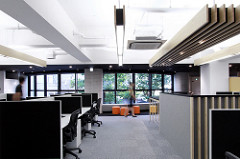 During a recent lunch conversation a comment was made about the great benefits of business intelligence (“BI”) – a tool used to connect lots of information dots to generate useful data. However, that was quickly followed by a second comment about the often failed attainment of those benefits. The culprit seems to be bad or incomplete historical data, ie data stuck in documents or inconsistently entered data.
During a recent lunch conversation a comment was made about the great benefits of business intelligence (“BI”) – a tool used to connect lots of information dots to generate useful data. However, that was quickly followed by a second comment about the often failed attainment of those benefits. The culprit seems to be bad or incomplete historical data, ie data stuck in documents or inconsistently entered data.
Another discussion at this lunch centered on co-tenancy, a complicated topic that impacts the commercial real estate industry. As an example, a co-tenancy clause could allow one tenant to reduce its rent if another, typically significant, tenant exits the property. The significant tenant is a draw to the property that benefits other tenants. So how do these two topics relate?
Well as it turns out, there is a great need to connect lots of co-tenancy dots for property owners. When a national retailer goes bankrupt, many property owners scramble to find out which properties had that significant tenant and then what other tenants in those properties had a co-tenancy clause that would allow them to reduce rent.
This type of situation can easily occur in other industries as well. Think about the situation where a drug is now known to have bad side effects. The connection of the drug to all the patients out there is probably only a handwritten note on a piece of paper – not very connectable in the BI world.
So what is the answer beyond an extremely costly process of reading every document and putting all of that data into a database? Although not perfect, the use of full text search in conjunction with digital documents associated with good data can help. Scan a document and associate that document with the patient’s social security number. If the document has the drug name in a typed format, you could do a search for the drug name within all digital patient files. If the documents are associated with the SSN, the search results will contain the names of all those patients.
For the commercial real estate industry, the search could be for “co-tenancy” and “significant tenant name”. The results are all documents with a co-tenancy clause for “significant tenant name” and if the documents are associated with the right data, the results will be very useful. Note that there are some limitations to this approach, but with the right prep work, the results will generate big benefits.
This poor man’s BI is available in all of Millennia Group’s document management systems, because our implementation process always includes associating documents to key lists of data like tenants, patients or customers. If you would like to learn more about our solutions, please contact us at info@mgdocs.com, (630) 279-0577 or visit www.mgdocs.com.





 Millennia Group just wrapped up being a sponsor and participant in the 19th annual Realcomm IBCON tradeshow in San Diego. This is a show dedicated to the understanding and use of technology in the commercial real estate industry. As one might expect for a technology show, there were some familiar topics including robotics, artificial intelligence, blockchain, virtual reality and renewable energy.
Millennia Group just wrapped up being a sponsor and participant in the 19th annual Realcomm IBCON tradeshow in San Diego. This is a show dedicated to the understanding and use of technology in the commercial real estate industry. As one might expect for a technology show, there were some familiar topics including robotics, artificial intelligence, blockchain, virtual reality and renewable energy.
 IRS Publication 4837, otherwise known as “Achieving Quality Examinations through Effective Planning, Execution and Resolution” published by the IRS Large Business and International Division, indicates that it would be wise to have supporting documents readily available when audited. Because you want to defend your position and you really don’t want the cost of responding to the audit to be greater than the potential tax impact.
IRS Publication 4837, otherwise known as “Achieving Quality Examinations through Effective Planning, Execution and Resolution” published by the IRS Large Business and International Division, indicates that it would be wise to have supporting documents readily available when audited. Because you want to defend your position and you really don’t want the cost of responding to the audit to be greater than the potential tax impact.
 During a recent lunch conversation a comment was made about the great benefits of business intelligence (“BI”) – a tool used to connect lots of information dots to generate useful data. However, that was quickly followed by a second comment about the often failed attainment of those benefits. The culprit seems to be bad or incomplete historical data, ie data stuck in documents or inconsistently entered data.
During a recent lunch conversation a comment was made about the great benefits of business intelligence (“BI”) – a tool used to connect lots of information dots to generate useful data. However, that was quickly followed by a second comment about the often failed attainment of those benefits. The culprit seems to be bad or incomplete historical data, ie data stuck in documents or inconsistently entered data.